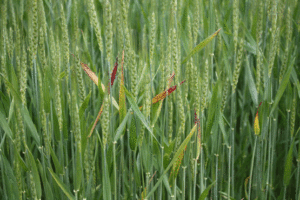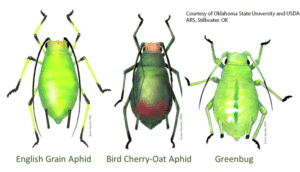LINKS
Management of Aphids and Barley Yellow Dwarf Virus in Tennessee Wheat (W 389)
Clay Perkins (Graduate Research Assistant), Scott Stewart (Professor), and Heather Kelly (Assistant Professor)
Department of Entomology and Plant Pathology
Barely Yellow Dwarf Virus and Symptoms
Barley yellow dwarf (BYD) is one of the most detrimental viral infections of small grains, including wheat. Seven viruses are currently known to cause BYD. A common symptom of BYD is stunting due to reduced internode length, and this is particularly apparent when infection occurs during the seedling stage. Stunting of plants can be so severe that no heads are produced or so mild that it is hard to recognize. Another conspicuous symptom of BYD is the discoloration of leaves. The leaves lose their green color and turn yellow and/or have a pink or reddish color, especially at their tips. Diagnosis may be complicated as there are many other causes of leaf yellowing. The presence of pink to reddish leaf tips is a more consistent indicator of BYD. In addition, the use of the enzyme-linked immunosorbent assay (ELISA) has proven to be an efficient way to confirm infection.
How it Spreads
 BYD is vectored by aphids. BYD can infect over 150 species of grasses. Aphids acquire the virus by feeding on an infected host, and it can be spread to other host plants such as wheat. The virus does not replicate in aphids but does circulate through the aphid body, hence the virus is retained by the aphid its entire life but is not passed from mother to young. Initial aphid infestations in wheat are often patchy in distribution, and thus, the stunting and leaf discoloration caused by BYD infection also often occurs in small patches ranging from one to five feet in diameter.
BYD is vectored by aphids. BYD can infect over 150 species of grasses. Aphids acquire the virus by feeding on an infected host, and it can be spread to other host plants such as wheat. The virus does not replicate in aphids but does circulate through the aphid body, hence the virus is retained by the aphid its entire life but is not passed from mother to young. Initial aphid infestations in wheat are often patchy in distribution, and thus, the stunting and leaf discoloration caused by BYD infection also often occurs in small patches ranging from one to five feet in diameter.
Aphids in Wheat
There are several aphid species (Hemiptera: Aphididae) found in wheat that have been implicated in the transmission of BYD. Some of these include the bird cherry-oat aphid, English grain aphid, greenbug, corn leaf aphid and rice root aphid. The first three species are most commonly observed in Tennessee.
Aphids are small, soft-bodied insects. They have sucking mouthparts used to puncture the plant tissue to feed on the phloem (sap) of plants. These aphids have varying and sometimes complex life cycles, but in wheat, they reproduce asexually and give birth to live young rather than laying eggs. Adults may be winged or wingless. Aphid color and the color and characteristics of the antennae and cornicles, the twin ‘tailpipes’ on the back of the abdomen, are used to distinguish the species found in wheat.
Because these aphids reproduce asexually, populations may grow quickly under optimal environmental conditions. When populations are high, honeydew may accumulate on the plant. However, with the possible exception of greenbug, it is the transmission of BYD and not the direct impact of feeding that is the greatest threat associated with aphid infestations. Yield reduction in wheat is greater when infection with BYD occurs prior to jointing (Feekes stage 6). The intensity of BYD infection in wild hosts and wheat varies geographically and across years, in part because aphid populations also vary.
Bird Cherry-Oat Aphid
The bird cherry-oat aphid, Rhopalosiphum padi, is the predominate aphid found in wheat. Nymphs are usually pale green and darken into a deep olive green color as they mature. Adults often have a dark brown to reddish-orange patch across their abdomen near their cornicles. The cornicles and antennae as well as the tops and tips of their leg segments are black. The body length for adults varies from 2.7-2.9 mm. The antennae are more than half as long as the body. Winged adults may be darker in color than wingless aphids. Bird cherry-oat aphids have a wide host range on grain crops. Its major host is the bird cherry tree, a close relative to the hackberry tree which is more common in Tennessee. This aphid can be found worldwide. Depending on temperature, an aphid will become capable of reproduction within 10-14 days of birth. Winged aphids become more common during stressful conditions such as unfavorable weather, overcrowding, or when the plant host deteriorates.
English Grain Aphid
The English grain aphid, Macrosiphum avenae, occurs in many wheat fields each year. They are pale green in color with black antennae and black cornicles, and the cornicles and antennae are longer than other aphid species normally observed in wheat. English grain aphids may be up to 2.5 mm in length. The English grain aphid feeds on a wide range of wild grasses and small grains. They will colonize wheat at any growth stage of the plant. They usually prefer the upper parts of the plant and are commonly found in wheat heads where the accumulation of honeydew and sooty mold are sometimes observed. The species can be found throughout the United States wherever small grains are grown.
Greenbug
 The greenbug, Schizaphis graminum, has been recognized as a major pest of small grains for over 150 years. However, it is a sporadic pest of wheat grown in Tennessee. Greenbugs are 1.3- 2.1 mm in length and pale green in color. A dark green stripe can be visible on large nymphs and adult aphids. Greenbugs also have a dark black tip to their legs and cornicles. Winged adults form during overpopulation or when the host plant is no longer suitable. The host range of greenbug includes 70 different grass species. Some of these include wheatgrass, oat, fescue, barley, rice, sorghum and wheat. Greenbugs can be found worldwide. A single female aphid can produce 1-8 offspring a day for two to three weeks. These young aphids can reach maturity within 6-10 days.
The greenbug, Schizaphis graminum, has been recognized as a major pest of small grains for over 150 years. However, it is a sporadic pest of wheat grown in Tennessee. Greenbugs are 1.3- 2.1 mm in length and pale green in color. A dark green stripe can be visible on large nymphs and adult aphids. Greenbugs also have a dark black tip to their legs and cornicles. Winged adults form during overpopulation or when the host plant is no longer suitable. The host range of greenbug includes 70 different grass species. Some of these include wheatgrass, oat, fescue, barley, rice, sorghum and wheat. Greenbugs can be found worldwide. A single female aphid can produce 1-8 offspring a day for two to three weeks. These young aphids can reach maturity within 6-10 days.
Management
Some wheat varieties have resistance to aphid infestations, especially greenbug, and partial resistance to barley yellow dwarf viruses. Unfortunately, this information is not always readily available from seed companies. Thus, one of the most consistent management approaches of preventing BYD is to plant during the recommended planting window. Early planted wheat is more likely to be infested by aphids during the fall which often results in higher infection with virus during the seedling stage. Consequently, planting is not recommended until October 15th or later which also helps avoid infestations from Hessian fly.
Insecticide seed treatments such as Gaucho® (imidacloprid), Cruiser® (thiamethoxam), and NipsIt Inside® (clothianidin) can also reduce transmission of BYD. Early planted wheat is most likely to benefit from use of a seed treatment. If a seed treatment is not used, a foliar insecticide application for aphid control during the fall (e.g., approximately 30 days after planting) and/or late winter (prior to March) may also reduce BYD. Insecticide applications should be made before aphid populations exceed 6-8 per linear foot of row; otherwise, any virus transmission may have already occurred. However, infection with BYD becomes less damaging as the plant grows, applications after jointing are less likely to increase yield.
Greenbug: This species injects a toxin while feeding, and thus, may cause yield loss above that caused by the transmission of BYD. Treatment should be made when aphids are killing three or more leaves per plant. For wheat less than 6 inches tall, treatment is suggested if greenbug numbers exceed 50 or more per linear foot. Treatment should also be made if greenbug numbers exceed 200 or more per linear foot in wheat 6-10 inches tall.
Please refer to the UT Insect Control Recommendations for Field Crops (PB 1768) for suggested chemical controls.
Sources
Bruehl, G. W. 1961. Barley yellow dwarf. American Phytopathological Society, Monograph No. 1.
Bockus, W. W., R. L. Bowden, R. M. Hunger, W. L. Morrill, T. D. Murray, and R. W. Smiley. 2010. Compendium of wheat diseases and pests, Third Edition. American Phytopathological Society, St. Paul, MN.
Stewart, S. D., R. Patrick, and A. McClure. 2016. Insect control recommendations for field crops: cotton, soybeans, field corn, sorghum, wheat, and pasture. University of Tennessee Extension, PB 1768.
Szczepaiec, A. 2013. Arthropod pests of wheat: aphids. South Dakota State University Extension, Pub. 03-2012-2013.
Whitworth, R. J. and A. Ahmad. 2008. Bird cherry-oat aphid, Kansas State University, MF-2832.
Printer Friendly PDF File: Management of Aphids and Barley Yellow Dwarf Virus in Tennessee Wheat (W389)







